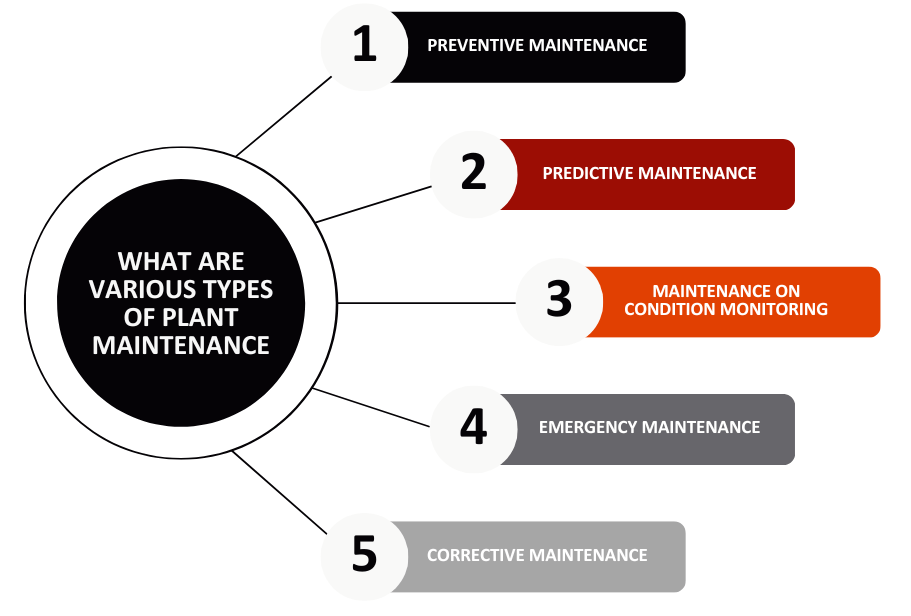Introduction
Every organization has several pieces of equipment, and every organization relies on some form of maintenance. Organizations involved in production and manufacturing, such as oil and gas, electronics, and pharmaceuticals, rely substantially on maintenance. A manufacturing unit utilizes plant maintenance!
Don’t know what plant maintenance means? Check out our previous blog.
In this blog, we will learn about plant maintenance types and objectives, as well as tips for successful implementation of Plant Maintenance Predictive Analytics Software.
So, to begin with,
What is Plant Maintenance?
Plant maintenance is a recurring process of repairing or maintaining the machine to avoid downtime. As we all know, the equipment in the plant are massive and run continually, which might reduce performance and cause breakdowns.
If unanticipated equipment failure occurs, the entire manufacturing process can be slowed, reducing output speed. If there is an unexpected downtime of equipment, the entire manufacturing process has to be halted, causing the production process to be delayed, which impacts the speed of delivery and leads to customer satisfaction. To avoid equipment failure, wear and tear parts and rusted portions of equipment are treated.
Plant maintenance can be planned or unplanned. It is determined by the equipment’s importance and priority. When the priority is high, asset maintenance is performed proactively. However, proactive maintenance takes into account a variety of parameters such as equipment utilization, performance, equipment age, and so on.
Plant maintenance can result in increased downtime since equipment maintenance is a lengthy procedure and the equipment is not in working order. As a result, maintenance must be planned in such a way that machine downtime is minimized.
What are various types of Plant Maintenance?
- Preventive Maintenance
Preventive maintenance (PM) is a proactive maintenance strategy designed to prevent equipment or machinery failures by performing routine and scheduled maintenance tasks. The primary goal of preventive maintenance is to ensure that assets, whether they are machines, vehicles, or other equipment, remain in optimal working condition, extend their lifespan, and reduce the likelihood of unexpected breakdowns.
- Predictive Maintenance
Predictive maintenance also allows organizations to plan maintenance ahead of time. In a predictive maintenance approach, the organization forecasts when an asset will fail and provides repairs to that asset just before it fails.
According to Market Research, “The global predictive maintenance market size was valued at $4,331.56 million in 2019, and is projected to reach $31,965.49 million by 2027, growing at a CAGR of 28.8% from 2020 to 2027.”
- Maintenance on Condition Monitoring
Maintenance based on condition monitoring can be a very successful method. However, it is costly, and it requires a competent maintenance staff. Why? Because it is proactive, and the asset is used to its full capacity and potential immediately prior to asset breakdown maintenance.
- Emergency Maintenance
Emergency maintenance occurs when an asset fails and has to be repaired as quickly as feasible. Emergency maintenance is used on assets that are very dependable but are not operating.
- Corrective Maintenance
Corrective maintenance, often known as reactive maintenance or breakdown maintenance, is a maintenance plan that addresses equipment or mechanical faults and difficulties as they arise. Maintenance actions are not planned or scheduled in advance under this method; rather, they are carried out in reaction to unforeseen breakdowns, malfunctions, or faults.
What Is the Objective of Plant Maintenance?
➔ To reduce equipment maintenance and downtime.
➔ Ensure that asset breakdown does not occur.
➔ Make maximum use of assets’ potential and capabilities.
➔ To preserve assets in good condition and to maximize asset performance.
➔ Reduce overall maintenance costs by leveraging surplus inventory.
➔ Provide maintenance to extend asset life.
10 Essential Line Items to Look for in a Plant Maintenance Predictive Analytics Software
Plant maintenance predictive analytics (PMPA) software can help organizations in optimizing your maintenance operations, reducing downtime, and improving overall equipment effectiveness (OEE). When selecting a PM/PA software solution, several factors must be considered, including your organization size, landscape complexity, budget and individual demands.
- User friendly interface
An intuitive and user-friendly interface is essential for ensuring that maintenance teams can browse and use the software with ease. Look for software with a clean and organized dashboard, customizable displays, and simple navigation. A user interface that is well-designed will increase user adoption and productivity.
- Asset and Equipment Management
Comprehensive asset management skills should be provided by effective plant maintenance software. As certain that the software is capable of tracking and managing all of your equipment, including asset data, maintenance history, and associated documents. This function simplifies asset management while lowering the risk of oversight.
- Work Orders and Maintenance Scheduling
The software should allow you to plan preventative maintenance tasks, issue work orders, and allocate them to individual personnel or teams. To maximize maintenance procedures and minimize downtime, look for systems that allow both calendar-based and condition-based scheduling.
- Condition Monitoring and Predictive Analytics
Predicting and preventing equipment breakdowns is one of the fundamental reasons for investing in maintenance software. Ensure to see if the software has strong predictive analytics capabilities, such as condition monitoring, data analysis, and the capacity to produce early warning alerts based on equipment health indicators.
- Mobile Compatibility
Maintenance staff are always on the go in today’s fast-paced industrial operations. Choose software that allows for mobile access via specialized apps or responsive web interfaces. This enables technicians to access important data and work orders in real time while away from their workplaces.
- Analytics and Reporting
Comprehensive reporting and analytics capabilities are required for monitoring key performance indicators (KPIs) and optimizing maintenance plans. To make informed decisions, look for software that provides customizable reports, real-time data visualization, and the capacity to analyze previous maintenance data.
- Integration Capabilities
Plant maintenance software should work in tandem with your existing business systems, such as ERP or Supervisory Control and Data Acquisition (SCADA) systems. Integration improves overall efficiency by ensuring data consistency and reducing human data entry.
- Scalability
Because your organization’s demands can vary over time, it’s critical to select a software solution that can grow with you. As your operations expand, ensure that the software can support an expanding number of assets, users, and data points.
- Compliance and Regulatory Assistance
Compliance with safety and environmental requirements is required in many businesses. Check that the software includes capabilities that will assist you in maintaining compliance, such as tracking regulatory requirements, documenting inspections, and producing compliance reports.
- Vendor Support and Training
Finally, assess the software vendor’s quality of support and training. Choose a provider who offers sufficient training materials, such as documentation, tutorials, and customer support. When problems develop or you want assistance with modification, responsive vendor support can be beneficial.
Last thought:
Investing in plant maintenance predictive analytics software is a big choice that can impact your business’s efficiency, production, and bottom line. You can make an informed choice that corresponds with your unique maintenance and predictive analytics needs by carefully analyzing software solutions based on the important line items provided in this blog.
Are you still confused? Check out this video and to know more about the tool, click on this link, and don’t forget that our experts are all set to deliver the best solution to improve and automate your business!
FAQ’s
How do predictive maintenance preventative maintenance work together?
Predictive and preventive maintenance, when combined, create an efficient maintenance program for equipment. This integration improves performance, minimizes downtime, reduces costs, and enhances safety.
What are the requirements for effective predictive and preventive maintenance?
Data gathering, data analysis, maintenance scheduling and planning, monitoring and assessment, continuous improvement, and staff participation are all essential components of a successful predictive and preventive maintenance (PdM and PM) approach.
What is preventive maintenance?
Preventive maintenance (PM) is a proactive strategy aimed at ensuring equipment stays in optimal condition, extends lifespan, and reduces unexpected failures through routine scheduled tasks.
What is predictive maintenance?
Predictive maintenance also allows organizations to plan maintenance ahead of time. In a predictive maintenance approach, the organization forecasts when an asset will fail and provides repairs to that asset just before it fails.
2 Comments
Comments are closed.



Attractive section of content I just stumbled upon your blog and in accession capital to assert that I get actually enjoyed account your blog posts Anyway I will be subscribing to your augment and even I achievement you access consistently fast
Thanks for thr great article!